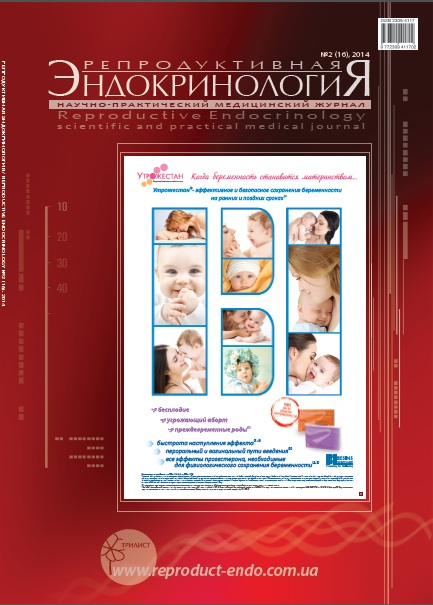From research to clinical practice: viewpoint on the problem of thrombotic risks in the use of oral and nonoral combined hormonal contraceptives
DOI:
https://doi.org/10.18370/2309-4117.2014.16.18-25Keywords:
combined hormonal contraceptives, venous thromboembolism, relative risk, NuvaRingAbstract
This paper is a review of contemporary scientific publications that deal with association of oral and non-oral forms of combined hormonal contraceptives with thrombotic events risk. Basing on the data analyzed, the following conclusion was made: in case of accurate adherence to medical eligibility criteria and adequate risk factors evaluation the use of combined hormonal contraceptives including vaginal ring NuvaRing leads to clinically nonsignificant thrombosis risk while the benefits of these medications overweigh risks of cardiovascular events.
Thus, the absolute risk of the use of combined hormonal contraceptives for women of reproductive age is extremely low (1-3 cases per 10 000 women). The risk of deaths as a result of venous thromboembolism while taking combined hormonal contraceptives is also low: the probability of death from venous thromboembolism is increased to 1 in 100 000 women if a relative risk level is 2. Increased risk of venous thromboembolism during pregnancy and the postpartum period are 29–30 cases per 10 000 women.
References
- Zhylka, N.Y. Vovk, I.B. «Family planning.» Education manual. Kyiv (2010): 300.
- World Health Organization. «Medical Eligibility Criteria for Contraceptive Use, 4th edition.» Geneva: WHO (2009), [http://www.who.int/reproductive_health/publications/mec/family_ planning/9789241563888/en/index.html].
- «Venous thromboembolism in women: a specific reproductive health risk.» Hum. Reprod. Update first published online July 3 (2013).
- Stegeman, В. «Hormonal contraceptives and venous thrombosis.» Department of Thrombosis and Hemostasis, Faculty of Medicine, Leiden University Library (LUMC), Leiden University, (2013).
- Shishkova, V.N. «Pitfalls of modern contraception: focus on the risk of thrombosis and metabolic disorders.» Journal Zemsky Doctor, 3(14) (2012).
- Samuel, Z. «Goldhaber Risk Factors for Venous Thromboembolism.» Journal of the American College of Cardiology, 56 (1) (2010).
- «Medical criteria of eligibility for contraceptive methods. What’s new in the world?» Information and Education Gazette «Family Health» (1) (2011).
- Skjeldestad, F.E. «Increased number of induced abortions in Norway after media coverage of adverse vascular events from the use of third-generation oral contraceptives.» Contraception, 55 (1997):11–14.
- Goodyear-Smith, A. Arroll, B. «Termination of pregnancy following panic-stopping of oral contraceptives.» Contraception, 66 (2002):163–167.
- Stegemanet, B.H. et al. «Different combined oral contraceptives and the risk of venous thrombosis: systematic review and network meta-analysis.» BMJ, (2013).
- Baratloo, A. et al. «The Risk of Venous Thromboembolism with Different Generation of Oral Contraceptives; a Systematic Review and Meta-Analysis.» Emergency, (2) (2014).
- Lidegaard, Ø. Løkkegaard, E. Svendsen, AL. et al. «Hormonal contraception and risk of venous thromboembolism: national follow-up study.» BMJ, 339 (2009):b2890.
- van Hylckama Vlieg, A. Helmerhorst, FM. Vandenbroucke, JP. et al. «The venous thrombotic risk of oral contraceptives, effects of estrogen dose and progestagen type: results of the MEGA case-control study.» BMJ, 339 (2009):b2921.
- Jick, SS. Hernandez, RK. «Risk of non-fatal venous thromboembolism in women using oral contraceptives containing drospirenone compared with women using oralcontraceptives containing levonorgestrel: case-control study using United States claims data.» BMJ, 340 (2011):d2151.
- Parkin, L. Sharples, K. Hernandez, RK. et al. «Risk of venous thromboembolism in users of oral contraceptives containing drospirenone or levonorgestrel: nested case-control study based on UK General Practice Research Database.» BMJ, 340 (2011):d2139.
Downloads
Published
How to Cite
Issue
Section
License
Copyright (c) 2014 Т. Ф Татарчук, Т. Н. Тутченко, Н. В. Яроцкая

This work is licensed under a Creative Commons Attribution 4.0 International License.
Authors who publish with this journal agree to the following terms:
- Authors retain copyright and grant the journal right of first publication with the work simultaneously licensed under a Creative Commons Attribution License that allows others to share the work with an acknowledgement of the work's authorship and initial publication in this journal.
- Authors are able to enter into separate, additional contractual arrangements for the non-exclusive distribution of the journal's published version of the work (e.g., post it to an institutional repository or publish it in a book), with an acknowledgement of its initial publication in this journal.







